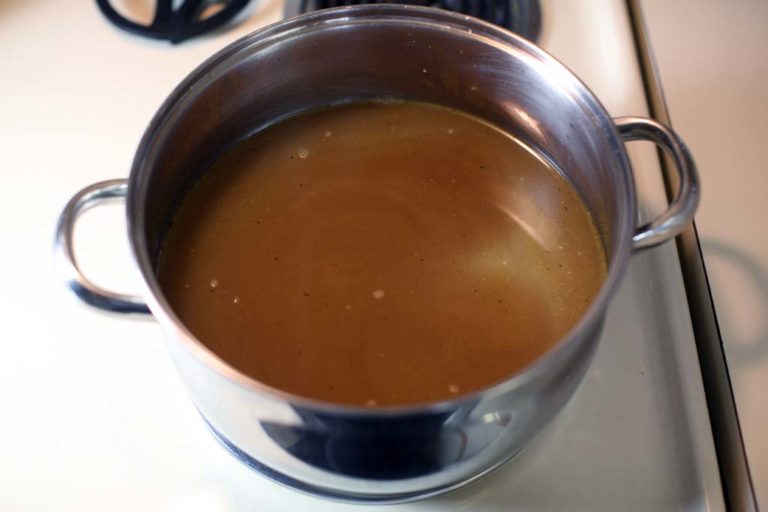
Chef's notes:
Stock is one of the most important items to have readily available in your kitchen, as it is the base for many sauces, gravies, soups, stews, pot roasts, and other braised meat dishes. Stock is a liquid made from the simmering of bones, vegetables, and other bits of kitchen fodder. Traditionally, stock is made from food not desired for consumption in its current, more complex form. Bones, cartilage, feet, joints, and skin are the most common items used to make animal-based stock. A broth is similar to stock, but the name “broth” usually implies that it was made with fresh meat and that it is seasoned in such a way that it could be consumed on its own. Stock is not prepared in this way. It is itself a raw ingredient in cooking from which broth could be made.
Ingredients
- Bones, skin, cartilage, and connective tissue from one chicken
- 2 white onions
- 3 carrots
- 3 ribs celery
- Bouquet garni: Parsley, Thyme,Bay leaves
Homemade Dark Chicken Stock Recipe made with Leftover Chicken, Mirepoix, Bouquet Garni, and Water (no salt)
- Assemble your chicken stock ingredients. For this stock I used the bones and skin of a medium-sized rooster from my brother’s farm, three old floppy carrots, three ribs of celery, two onions, and a bouquet garni. Put the chicken in the stock pot and pour enough water in to cover the chicken by about an inch. Simmer the bones for a few minutes. Some scummy stuff will come to the surface; skim that off. Next, add everything else and continue to simmer, NOT BOIL, with the stock covered.
- Skim off fat and other scummy things from the chicken stock. As the stock simmers, some scum and foam will come to the top. Skim off that with a spoon. I know the urge to stir the stock is great, but don’t give in. Stirring will break up bigger pieces into smaller pieces. These little pieces will float around and cause your stock to become cloudy. Clear stock is naturally more aesthetically pleasing.
- Pour the chicken stock through a fine-mesh strainer. After 3–4 hours, the stock should be done. The best way to get all the chucks out of the pot quickly is to pour the whole thing through a fine mesh strainer. But a few pieces of cheesecloth laid inside of a colander will also get the job done. You could even pour the whole thing through a coffee filter if you have the patience. This works really well to get all the little floaters out.
- You must cool the chicken stock quickly. This large volume of liquid needs to cool quickly to decrease the risk for foodborne illness. The best way to do that is to submerge the pot into an ice bath and stir the stock. Once the stock is below a hundred degrees, store it in the fridge or divide it up and freeze it for up to three months.
Tips & Tricks
- Apart from vegetable stock, chicken stock is perhaps the easiest to prepare. All you need is chicken, vegetables, water, and herbs. Simmer them for 3–4 hours, strain, and store. According to the French, the best vegetables are celery, carrot, and onion. This combination of vegetables is called a mirepoix. These don’t necessarily have to be whole vegetables. For example, you can use carrot peels, onion skins, and celery tops instead. It will depend on what you have available.
- The nice thing about bouquet garni is that it makes it easier to find the bay leaf. Traditionally, it is made with parsley, thyme, and bay leaf. But some other herbs are used depending on the situation. Basil, celery, chervil, tarragon, rosemary, and savory are popular. In this case, I am using curly parsley, some old thyme ,and some fresh bay leaf (a.k.a. laurel).
- To tie a bouquet garni, grab all the herbs at the base and hold them tightly. Use a short piece of butcher’s twine, wrap it around once, and tie a square knot to cinch it up. Wrap the twine around again and tie a double square knot. Trim the ends.
